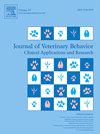Owner reported prevalence and severity of canine aggression in the United States: A descriptive study
IF 1.3
3区 农林科学
Q4 BEHAVIORAL SCIENCES
Journal of Veterinary Behavior-clinical Applications and Research
Pub Date : 2025-04-09
DOI:10.1016/j.jveb.2025.04.002
引用次数: 0
Abstract
Canine aggression is a behavior problem of significance for the safety of people and other animals. The prevalence of various aggressive actions has been reported by various authors, but there is a considerable range of values given. In addition, data was determined is several ways, using a variety of questions, and comes from numerous countries where different breeds and ways of raising dogs exist. For that reason, the data from 43,517 dogs enrolled in the Dog Aging Project (DAP), entered by their owners, was used to understand the extent of owner perceived agonistic behavior in dogs living in the United States. Ten behavior questions were used under the section of titled “Aggression” and were divided into four multi-question categories (i.e., aggression to unfamiliar people, familiar people, unfamiliar dogs, and familiar dogs). All questions were rated by the owner on a five-point Likert-type scale between 0 (no aggression), 1 and 2 (moderate aggression), and 3 and 4 (serious aggression). Data were analyzed to determine the prevalence of dogs showing all levels of agonistic behavior by category in response to the ten questions. Overall, 57.5% of all dogs in the study received at least one rating of level 2 (moderate) or higher in severity. Aggression towards unfamiliar people was shown by 38.8% of dogs, towards familiar people was shown by 5.4% of dogs, towards unfamiliar dogs was shown by 49.9% of dogs, and towards familiar dogs was approximately 14.5%.
在美国,主人报告了犬类攻击的普遍性和严重性:一项描述性研究
犬的攻击行为是对人类和其他动物安全具有重要意义的行为问题。不同的作者报告了各种攻击行为的发生率,但给出的数值范围相当大。此外,数据是通过多种方式、使用多种问题确定的,并且来自于存在不同犬种和饲养方式的众多国家。因此,我们使用了 43,517 只参加了 "狗老龄化项目"(DAP)的狗的数据(由狗的主人输入),以了解美国狗的主人认为狗的激动行为的程度。在题为 "攻击 "的部分中使用了十个行为问题,并分为四个多问题类别(即对不熟悉的人、熟悉的人、不熟悉的狗和熟悉的狗)。所有问题均由主人用李克特五点量表进行评分,0 分(无攻击行为)、1 分和 2 分(中度攻击行为)以及 3 分和 4 分(严重攻击行为)。通过对数据进行分析,确定了在回答十个问题时出现各种程度攻击行为的狗的比例。总体而言,研究中 57.5% 的狗至少有一次被评为 2 级(中度)或更严重。38.8%的狗对不熟悉的人表现出攻击行为,5.4%的狗对熟悉的人表现出攻击行为,49.9%的狗对不熟悉的狗表现出攻击行为,而对熟悉的狗表现出攻击行为的比例约为 14.5%。
本文章由计算机程序翻译,如有差异,请以英文原文为准。
求助全文
约1分钟内获得全文
求助全文
来源期刊
CiteScore
3.50
自引率
16.70%
发文量
107
审稿时长
325 days
期刊介绍:
Journal of Veterinary Behavior: Clinical Applications and Research is an international journal that focuses on all aspects of veterinary behavioral medicine, with a particular emphasis on clinical applications and research. Articles cover such topics as basic research involving normal signaling or social behaviors, welfare and/or housing issues, molecular or quantitative genetics, and applied behavioral issues (eg, working dogs) that may have implications for clinical interest or assessment.
JVEB is the official journal of the Australian Veterinary Behaviour Interest Group, the British Veterinary Behaviour Association, Gesellschaft fr Tierverhaltensmedizin und Therapie, the International Working Dog Breeding Association, the Pet Professional Guild, the Association Veterinaire Suisse pour la Medecine Comportementale, and The American Veterinary Society of Animal Behavior.

 求助内容:
求助内容: 应助结果提醒方式:
应助结果提醒方式:


